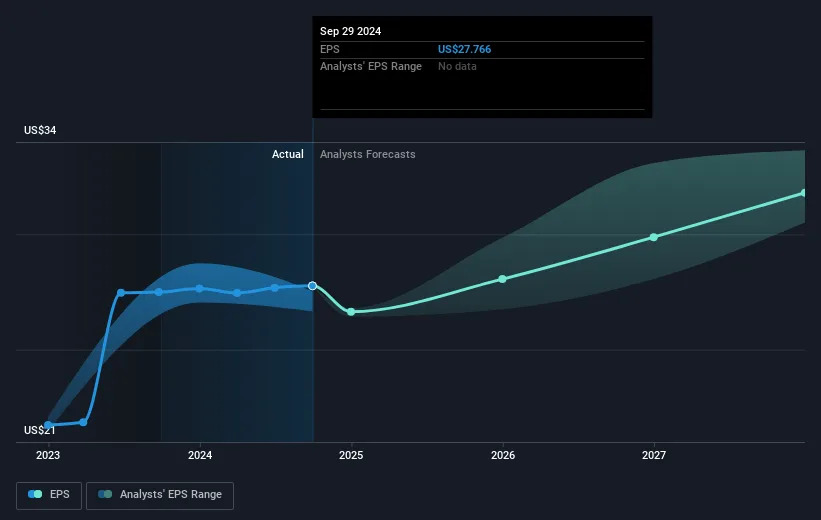January 20, 2025

It hasn't been the best quarter for Lockheed Martin Corporation ( NYSE:LMT ) shareholders, since the share price has fallen 15% in that time. But at least the stock is up over the last three years. However, it's unlikely many shareholders are elated with the share price gain of 31% over that time, given the rising market.
Now it's worth having a look at the company's fundamentals too, because that will help us determine if the long term shareholder return has matched the performance of the underlying business.
Check out our latest analysis for Lockheed Martin
To quote Buffett, 'Ships will sail around the world but the Flat Earth Society will flourish. There will continue to be wide discrepancies between price and value in the marketplace...' One imperfect but simple way to consider how the market perception of a company has shifted is to compare the change in the earnings per share (EPS) with the share price movement.
During three years of share price growth, Lockheed Martin achieved compound earnings per share growth of 8.9% per year. We don't think it is entirely coincidental that the EPS growth is reasonably close to the 10% average annual increase in the share price. This observation indicates that the market's attitude to the business hasn't changed all that much. Au contraire , the share price change has arguably mimicked the EPS growth.
The graphic below depicts how EPS has changed over time (unveil the exact values by clicking on the image).
This free interactive report on Lockheed Martin's earnings, revenue and cash flow is a great place to start, if you want to investigate the stock further.
When looking at investment returns, it is important to consider the difference between total shareholder return (TSR) and share price return . The TSR incorporates the value of any spin-offs or discounted capital raisings, along with any dividends, based on the assumption that the dividends are reinvested. Arguably, the TSR gives a more comprehensive picture of the return generated by a stock. We note that for Lockheed Martin the TSR over the last 3 years was 42%, which is better than the share price return mentioned above. The dividends paid by the company have thusly boosted the total shareholder return.
Lockheed Martin shareholders are up 9.7% for the year (even including dividends). But that was short of the market average. The silver lining is that the gain was actually better than the average annual return of 5% per year over five year. This could indicate that the company is winning over new investors, as it pursues its strategy. It's always interesting to track share price performance over the longer term. But to understand Lockheed Martin better, we need to consider many other factors. To that end, you should be aware of the 1 warning signwe've spotted with Lockheed Martin .
Of course Lockheed Martin may not be the best stock to buy . So you may wish to see this free collection of growth stocks.
Please note, the market returns quoted in this article reflect the market weighted average returns of stocks that currently trade on American exchanges.
Have feedback on this article? Concerned about the content?
Get in touch
with us directly.
Alternatively, email editorial-team (at) simplywallst.com.
This article by Simply Wall St is general in nature.
We provide commentary based on historical data and analyst forecasts only using an unbiased methodology and our articles are not intended to be financial advice.
It does not constitute a recommendation to buy or sell any stock, and does not take account of your objectives, or your financial situation. We aim to bring you long-term focused analysis driven by fundamental data. Note that our analysis may not factor in the latest price-sensitive company announcements or qualitative material. Simply Wall St has no position in any stocks mentioned.